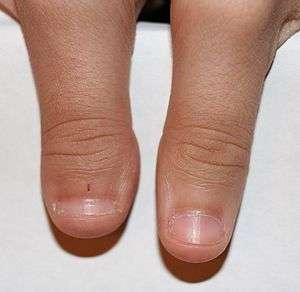Brachydactyly type D
| Brachydactyly type D | |
|---|---|
 | |
| Child's thumbs with unilateral brachydactyly type D (with bitten nails giving the shortness a more extreme appearance than normally-treated nails) | |
| Classification and external resources | |
| eMedicine | I/ |
Stub thumb[1] is a condition clinically recognised by a thumb being relatively short and round with an accompanying wide nail bed as the distal phalanx of affected thumbs is approximately two-thirds of full-length thumbs. Classified as brachydactyly type D, this skeletal variation is associated with the HOXD13 gene.
Term
Stub thumbs are medically classified as brachydactyly type D (BDD) alias brachymegalodactylism.[1][2] Coined by R.A. Hefner in 1924, 'stub thumb' is a scientifically preferred term used to identify brachydactyly type D.[1][2] Stub thumbs have also been called murderer's thumb (allegedly among fortune tellers)[1] and potter's thumb.[2]
Physics
Brachydactyly type D is a skeletal condition allegedly caused by a 'partial fusion or premature closing of the epiphysis with the distal phalanx of the thumb', according to Goodman et alia (1965). J.K. Breithenbecher (1923) found that distal phalanges of stub thumbs were one-half the length of full-length thumbs, while R.M. Stecher (1957) claimed that it be approximately two-thirds. The condition may either be unilateral (affecting one thumb) or bilateral (affecting both).[1]
Genetics
A genetic trait, brachydactyly type D exhibits autosomal dominance and is commonly developed or inherited independently of other hereditary traits. The condition is associated with the HOXD13 gene, which is central in digital formation and growth.[2]
Frequency
A 1965 scientific study in Israel found that 3.05% of Israeli Arabs had one or two stub thumbs, compared with 1.57% among Ashkenazi as well as non-Ashkenazi Jews.[1] However, as the survey's Arab test persons were mainly recruited from a handful of large and closely related clans living in a particular village, said percentage should be 'considered with some reservation', according to Goodman et alia (1965). Stub thumbs are also relatively common in Japan.
References
Literature
- Breitenbecher, J. K. (1923). "Hereditary Shortness of Thumbs". Journal of Heredity. 14: 15–22. doi:10.1093/oxfordjournals.jhered.a102263.
- GOODMAN RM; ADAM A; SHEBA C (1965). "A Genetic Study of Stub Thumbs Among Various Ethnic Groups in Israel". Journal of Medical Genetics. 2 (2): 116–21. PMC 1012845. PMID 14295653.
- Goodman, R. M.; Feinstein, A.; Hertz, M. (1984). "Stub thumbs in Israel revisited". Journal of Medical Genetics. 21 (6): 460–2. PMC 1049348. PMID 6512836.
- Hefner, R. A. (1924). "INHERITED ABNORMALITIES OF THE FINGERS: I. Symphalangism". Journal of Heredity. 15 (8): 323–329. doi:10.1093/oxfordjournals.jhered.a102481.
- Hefner, R. A. (1924). "Inherited Abnormalities of the Fingers". Journal of Heredity. 15 (10): 433–439. doi:10.1093/oxfordjournals.jhered.a102395.
- Hefner, R. A. (1924). "INHERITED ABNORMALITIES OF THE FINGERS—:III. Subterminal Articulation in the Proximal Joint of the Little Finger". Journal of Heredity. 15 (12): 481–484. doi:10.1093/oxfordjournals.jhered.a102406.
- McKusick, Victor A. 'Brachydactyly, Type D; BDD'. Online Mendelian Inheritance in Man. Retrieved on 2 May 2018. https://omim.org/entry/113200
- Sayles, Leonard P.; Jailer, Joseph W. (1934). "Four Generations of Short Thumbs". Journal of Heredity. 25 (9): 377–378. doi:10.1093/oxfordjournals.jhered.a103971.
- Stecher, R.M. (1957). "The Physical Characteristics and Heredity of Short Thumbs". Human Heredity. 7: 217–222. doi:10.1159/000150970.
- Villaverde, M. M.; Da Silva, J. A. (1975). "Distal brachyphalangy of the thumb in mental retardation". Journal of Medical Genetics. 12 (4): 401–4. PMC 1013320. PMID 1240973.
- Wildervanck, L.S. 1955. 'Erfelijke brachyphalangie van der einkootjes der duimen in twee families; in een dier families tevens hereditaire valgusstand van de Kleine tenen'. Nederlands Tijdschrift voor Geneeskunde.